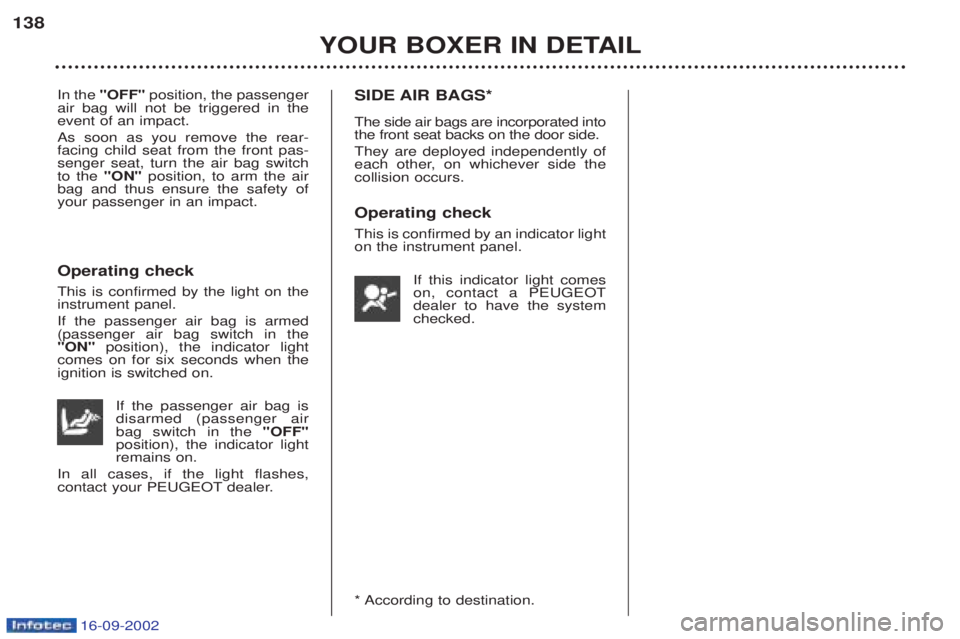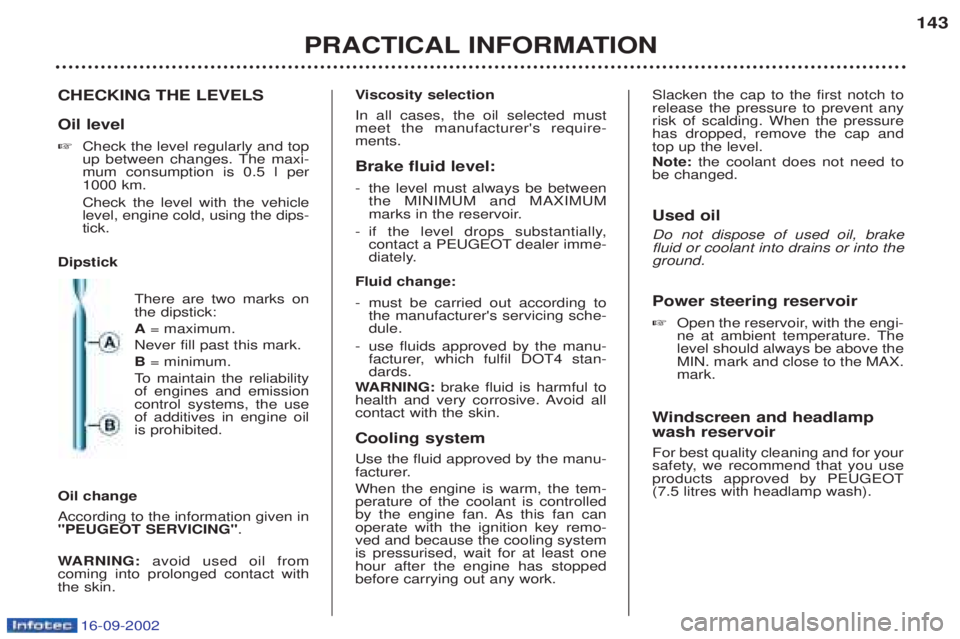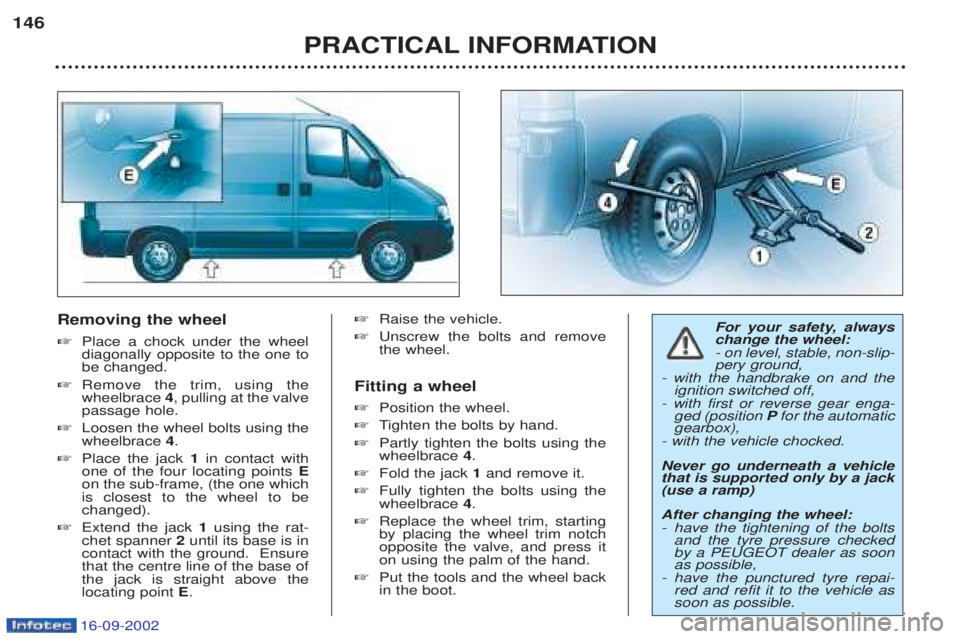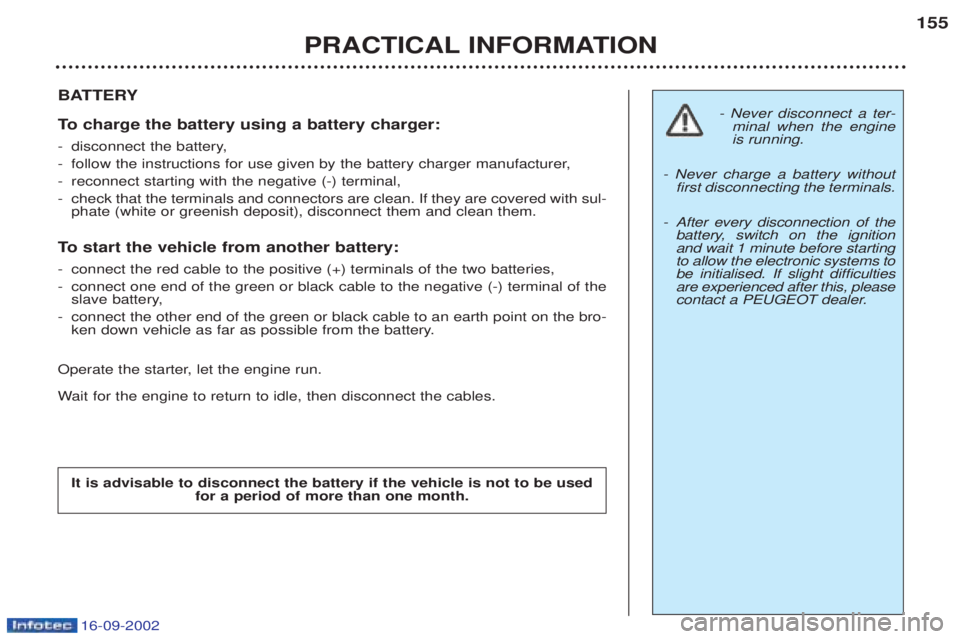Page 139 of 182

16-09-2002
YOUR BOXER IN DETAIL
138
In the
"OFF" position, the passenger
air bag will not be triggered in the event of an impact. As soon as you remove the rear- facing child seat from the front pas-senger seat, turn the air bag switchto the "ON"position, to arm the air
bag and thus ensure the safety ofyour passenger in an impact. Operating check This is confirmed by the light on the instrument panel. If the passenger air bag is armed (passenger air bag switch in the"ON" position), the indicator light
comes on for six seconds when theignition is switched on.
If the passenger air bag isdisarmed (passenger airbag switch in the "OFF"
position), the indicator lightremains on.
In all cases, if the light flashes,
contact your PEUGEOT dealer. SIDE AIR BAGS* The side air bags are incorporated into the front seat backs on the door side. They are deployed independently of
each other, on whichever side thecollision occurs. Operating check This is confirmed by an indicator light on the instrument panel.
If this indicator light comeson, contact a PEUGEOTdealer to have the systemchecked.
* According to destination.
Page 144 of 182

16-09-2002
PRACTICAL INFORMATION143
CHECKING THE LEVELS Oil level ☞ Check the level regularly and top
up between changes. The maxi-mum consumption is 0.5 l per1000 km. Check the level with the vehicle level, engine cold, using the dips-tick.
Dipstick
There are two marks onthe dipstick: A= maximum.
Never fill past this mark.B = minimum.
To maintain the reliability
of engines and emission control systems, the useof additives in engine oilis prohibited.
Oil change According to the information given in
"PEUGEOT SERVICING" .
W ARNING: avoid used oil from
coming into prolonged contact withthe skin.
V iscosity selection
In all cases, the oil selected must meet the manufacturer's require-ments. Brake fluid level: - the level must always be between the MINIMUM and MAXIMUM
marks in the reservoir.
- if the level drops substantially,
contact a PEUGEOT dealer imme-
diately.
Fluid change: - must be carried out according to the manufacturer's servicing sche-dule.
- use fluids approved by the manu-
facturer, which fulfil DOT4 stan-dards.
W ARNING: brake fluid is harmful to
health and very corrosive. Avoid allcontact with the skin. Cooling system Use the fluid approved by the manu-
facturer. When the engine is warm, the tem- perature of the coolant is controlled
by the engine fan. As this fan canoperate with the ignition key remo-ved and because the cooling systemis pressurised, wait for at least onehour after the engine has stoppedbefore carrying out any work. Slacken the cap to the first notch torelease the pressure to prevent anyrisk of scalding. When the pressurehas dropped, remove the cap andtop up the level. Note:
the coolant does not need to
be changed. Used oil Do not dispose of used oil, brake fluid or coolant into drains or into theground. Power steering reservoir ☞ Open the reservoir, with the engi-
ne at ambient temperature. Thelevel should always be above theMIN. mark and close to the MAX.mark.
W indscreen and headlamp
wash reservoir For best quality cleaning and for your
safety, we recommend that you useproducts approved by PEUGEOT(7.5 litres with headlamp wash).
Page 146 of 182
16-09-2002
PRACTICAL INFORMATION145
CHANGING A WHEEL Parking the vehicle ☞
Park the vehicle on level, stable and non-slippery ground.
☞ Apply the handbrake, switch offthe ignition and engage first orreverse gear (position Pfor the
automatic gearbox).
Tools
The following tools are in a holderunder the front passenger seat: 1 - Jack.
2 - Ratchet spanner.
3 - Spare wheel carrier access socket.
4 - Wheelbrace.
5 - Screwdriver (for removal of the grille when changing bulbs).
Access to the spare wheel The spare wheel is located in a car- rier underneath the vehicle at the
rear. The two carrier support bolts are located near the outer edge of the
rear floor. ☞
Unclip the covers on the bolts.
☞ Slacken these two bolts using a ratchet spanner 2and the socket
3 .
☞ Lift the carrier to release theretaining hook using the wheel-brace 4.
Page 147 of 182

16-09-2002
Removing the wheel ☞Place a chock under the wheel diagonally opposite to the one tobe changed.
☞ Remove the trim, using thewheelbrace 4, pulling at the valve
passage hole.
☞ Loosen the wheel bolts using thewheelbrace 4.
☞ Place the jack 1in contact with
one of the four locating points E
on the sub-frame, (the one whichis closest to the wheel to bechanged).
☞ Extend the jack 1using the rat-
chet spanner 2until its base is in
contact with the ground. Ensurethat the centre line of the base ofthe jack is straight above thelocating point E. ☞
Raise the vehicle.
☞ Unscrew the bolts and removethe wheel.
Fitting a wheel ☞ Position the wheel.
☞ Tighten the bolts by hand.
☞ Partly tighten the bolts using the wheelbrace 4.
☞ Fold the jack 1and remove it.
☞ Fully tighten the bolts using thewheelbrace 4.
☞ Replace the wheel trim, startingby placing the wheel trim notchopposite the valve, and press iton using the palm of the hand.
☞ Put the tools and the wheel backin the boot. For your safety, always change the wheel: - on level, stable, non-slip- pery ground,
- with the handbrake on and the ignition switched off,
- with first or reverse gear enga- ged (position Pfor the automatic
gearbox),
- with the vehicle chocked. Never go underneath a vehicle that is supported only by a jack(use a ramp) After changing the wheel: - have the tightening of the bolts and the tyre pressure checkedby a PEUGEOT dealer as soonas possible,
- have the punctured tyre repai- red and refit it to the vehicle assoon as possible.
PRACTICAL INFORMATION
146
Page 157 of 182

16-09-2002
PRACTICAL INFORMATION155
BATTERY
To
charge the battery using a battery charger:
- disconnect the battery,
- follow the instructions for use given by the battery charger manufacturer,
- reconnect starting with the negative (-) terminal,
- check that the terminals and connectors are clean. If they are covered with sul- phate (white or greenish deposit), disconnect them and clean them.
To start the vehicle from another battery:
- connect the red cable to the positive (+) terminals of the two batteries,
- connect one end of the green or black cable to the negative (-) terminal of the
slave battery,
- connect the other end of the green or black cable to an earth point on the bro-
ken down vehicle as far as possible from the battery.
Operate the starter, let the engine run. W ait for the engine to return to idle, then disconnect the cables.
- Never disconnect a ter-
minal when the engine is running.
- Never charge a battery without first disconnecting the terminals.
- After every disconnection of the
battery, switch on the ignitionand wait 1 minute before startingto allow the electronic systems tobe initialised. If slight difficultiesare experienced after this, please
contact a PEUGEOT dealer.
It is advisable to disconnect the battery if the vehicle is not to be used for a period of more than one month.